Warning: pic heavy, as usual. 
UPDATE JUNE 8, 2011: Thrunite has revised the Scorpion with a new version that address all the issues identified in this review (along with greatly increased max output, efficiency, and throw). Check my new Scorpion V2 review for the currently shipping version.
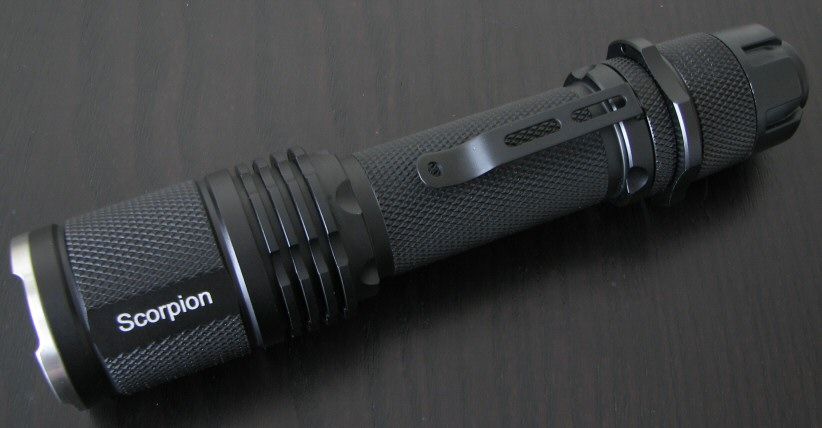
The Scorpion is a new XM-L based light from Thrunite, with an interesting tailcap control interface. Let's see how it performs …
Specifications:
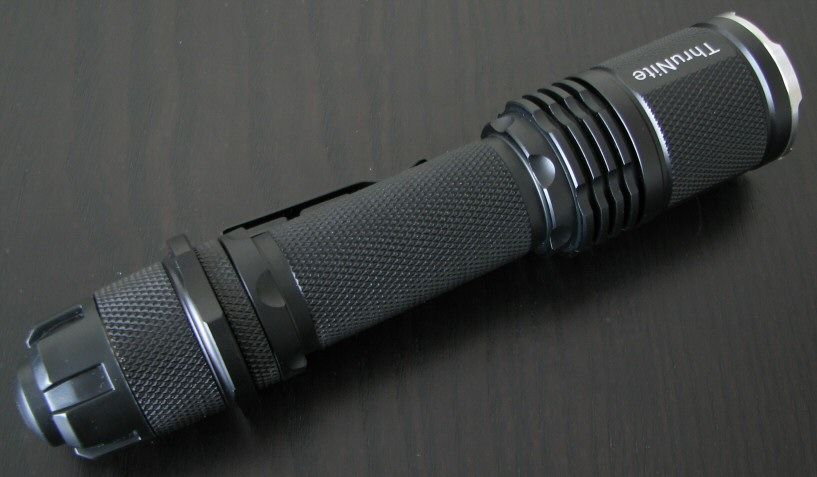
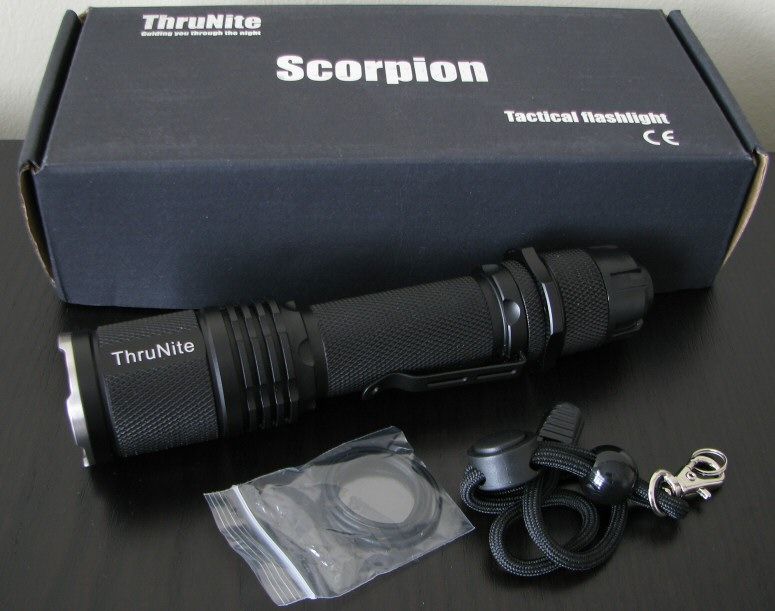
Packaging is similar to the Catapult line of lights (i.e. simple cardboard case with cut-out foam). Iinside you will find the light, wrist lanyard, and spare o-rings. There was no manual or warranty card on my sample, but those are usually standard with Thrunite.
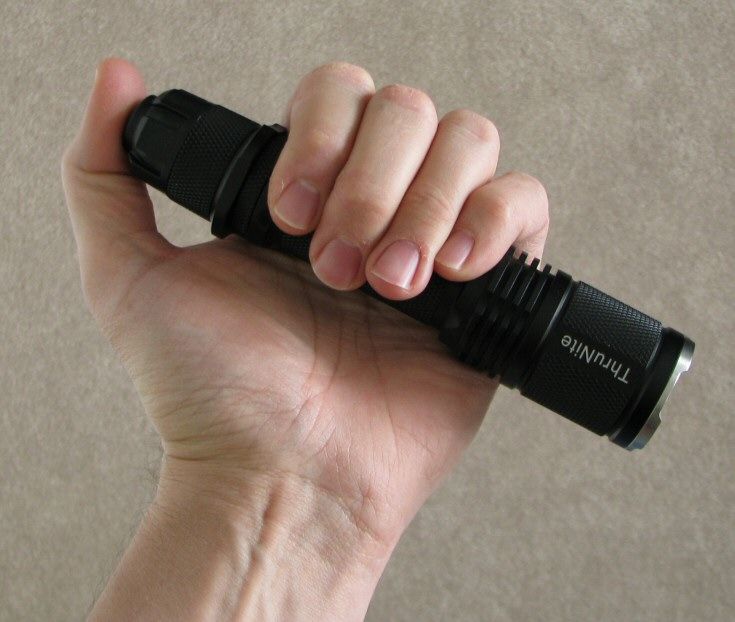
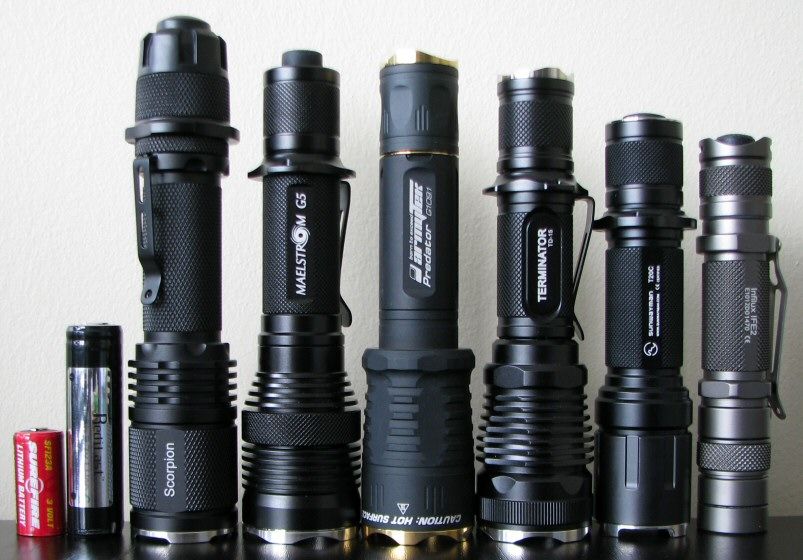
From left to right: Surefire CR123A, Redilast 18650, Thrunite Scorpion, 4Sevens Maelstrom G5, Armytek Predator, Lumintop TD-15, Sunwayman T20C, NiteCore IFE2.
Scorpion: Weight: 167.5g (no batteries), Length: 168mm, Width: 35.1 (bezel), 37.0mm (tailcap grip ring)
TD-15X: Weight 150.3g (no batteries), Length 147.3mm, Width: 37.8mm (bezel)
The Scorpion is a bit beefier that other lights in this class, with apparently heavier heatsinking in the head (noticeable head weight difference compared to other lights). Length is also a little longer than typical, due to the control ring in the tailcap.
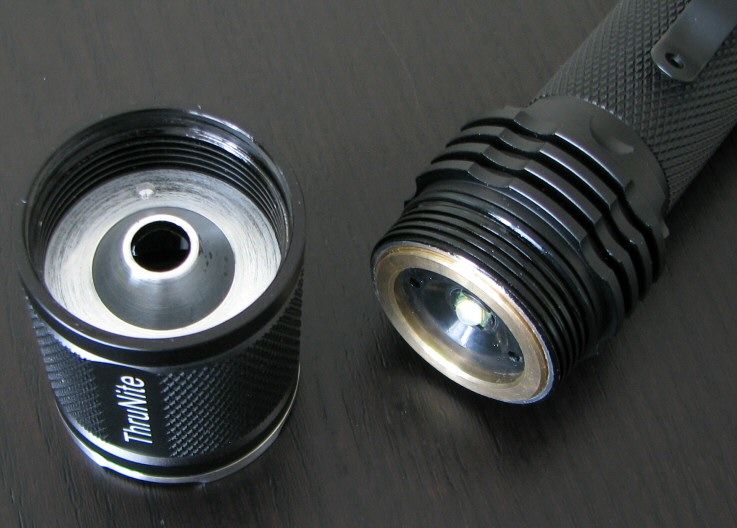
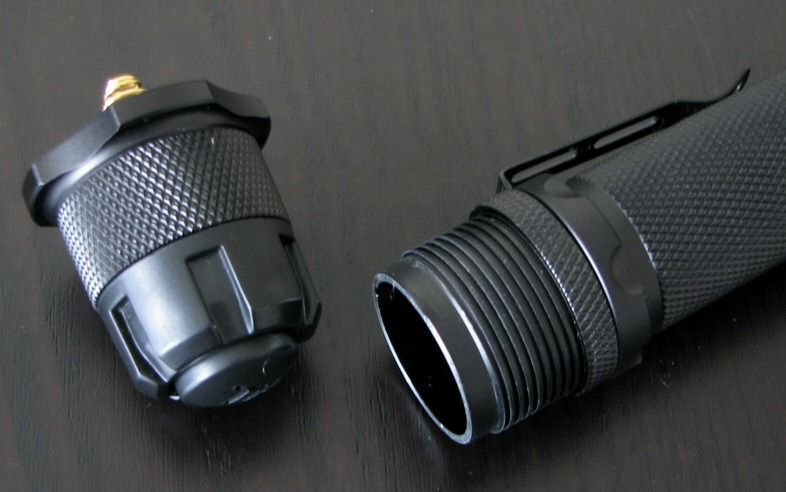
The most distinctive part of this light is the tailcap, so let me get the other items out of the way first.
The head is a bit heftier than most lights, and seems to have excellent heatsinking. Since the tailcap is also beefier than normal, this tends to balance out the weight reasonably well. Overall, the light feels quite solid and durable – as you would expect from Thrunite.
Clip is removable, with a knurled ring cover to hide the attachment point. Note the clip is not reversible, however.
Black anodizing (type III = HA) is in matte finish, similar to the Neutron series. Lettering (which is minimal) is bright and clear. Knurling is reasonably aggressive (similar to the Neutron series), and there is a generous amount of it over the light and tailcap. Grip is good, especially with the removable clip and built-in tailcap aluminum grip ring.
Square-cut screw threads are anodized for tailcap lock-out.
There is a spring on the positive contact plate in the head, insuring contact for flat-top cells. Be advised however that I had trouble getting most of my high-capacity 18650 cells to work in the light. I suspect the problem was the resistance of the two battery springs making it hard to screw the tailcap all the way down (i.e. to get past the anodized lock-out).
Light cannot tailstand.
So, what about that tailcap?
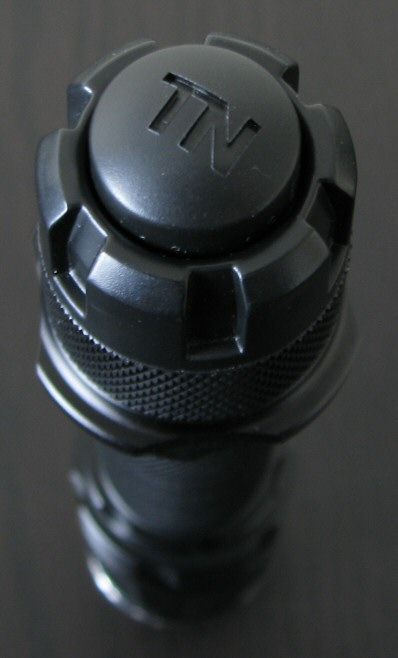
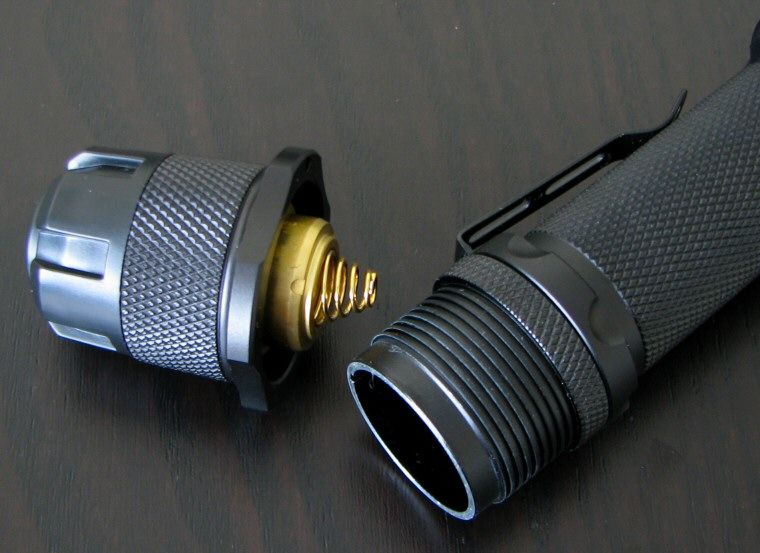
First off, doesn't it look familiar? Although I don't own one, it appears to be remarkably similar to the Night-Ops Gladius. Not surprisingly, the interface is also nearly identical to that of the Gladius, except for the addition of the extra Firefy mode on the Scorpion.
The tailcap exterior is composed of two distinct regions – a metal base (the grip ring and knurled region) and a polymer (i.e. plastic) control ring and switch. The control ring is directly connected to the substantial spring assembly unit inside the head, and the whole area spins freely when the tailcap is not attached. Aside from aesthetic touches - like the "TN" logo stamped on the button, and the shape of the grip ring and knurling - this tailcap is a dead ringer for the Gladius.
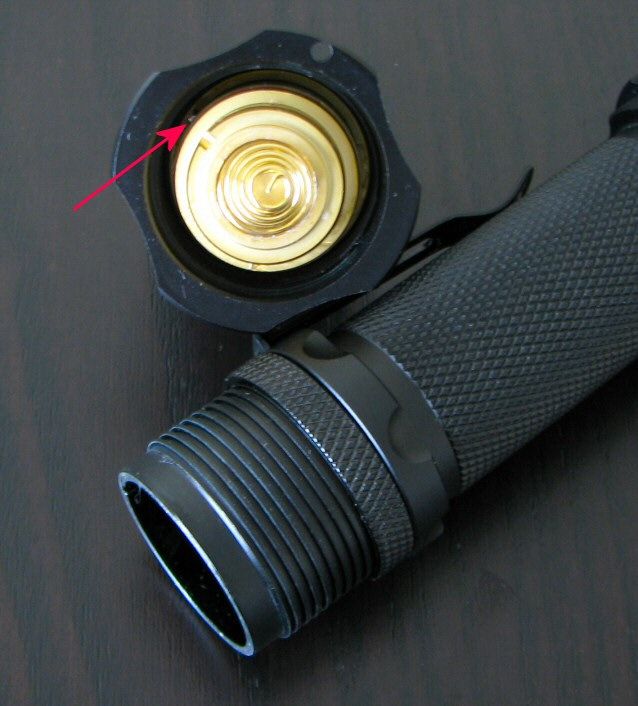
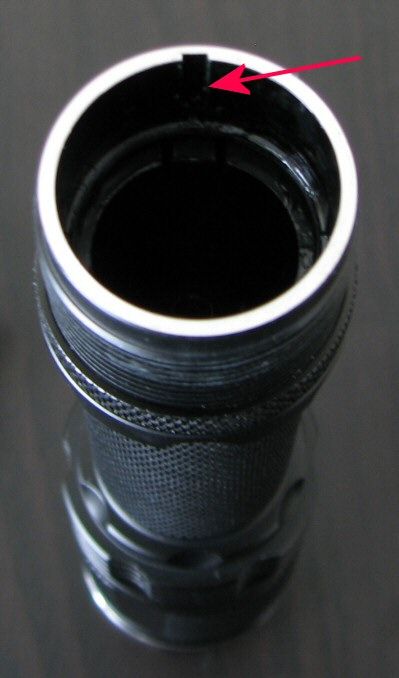
On the interior of the switch, you will see there is a small ridge, or raised area of the switch base (arrow in the top pick). This corresponds to the grove clearly visible on the inside of the body tube (arrow in the bottom pic). Again, this is identical to the Gladius – that raised area on the switch locks into this groove during assembly.
 It is very important you carefully line up the groove area with the tailcap ridge (by turning the plastic control ring) before tightening the switch assembly (by screwing the tailcap by the metal grip area). Although it was fairly forgiving in my testing, you don't ever want to force the tailcap when screwing on - you may damage the switch if overly careless. Once in the groove, the control ring now moves between 4 clear detents that set the output modes of the light.
It is very important you carefully line up the groove area with the tailcap ridge (by turning the plastic control ring) before tightening the switch assembly (by screwing the tailcap by the metal grip area). Although it was fairly forgiving in my testing, you don't ever want to force the tailcap when screwing on - you may damage the switch if overly careless. Once in the groove, the control ring now moves between 4 clear detents that set the output modes of the light.
For more on how the control ring works, please see my User Interface discussion below.
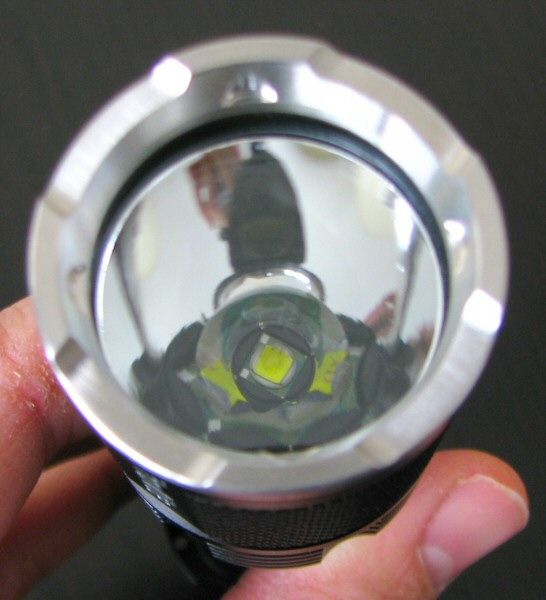
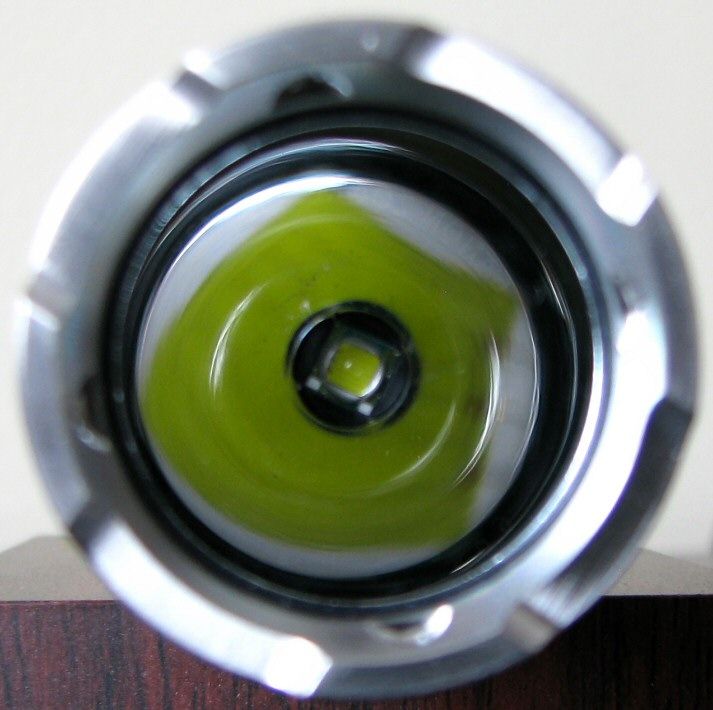
The Scorpion has a fairly deep and smooth reflector, with a well-centered XM-L emitter on my sample. I would expect reasonably good throw with this reflector, but not as great as larger "thrower" lights.
Which brings me to the white-wall beamshots. All lights are on AW protected 18650, about ~0.75 meter from a white wall (with the camera ~1.25 meters back from the wall). Automatic white balance on the camera, to minimize tint differences.
All lights are on AW protected 18650, about ~0.75 meter from a white wall (with the camera ~1.25 meters back from the wall). Automatic white balance on the camera, to minimize tint differences.
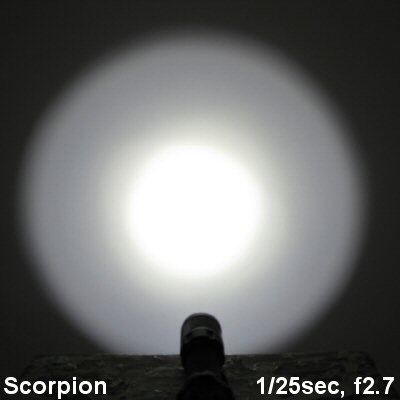
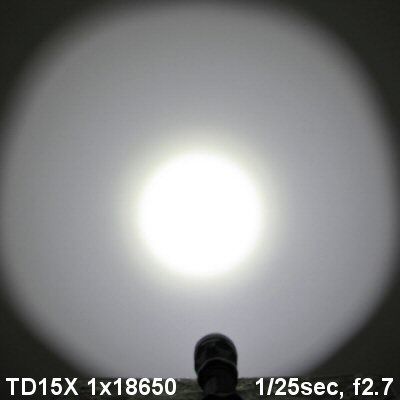
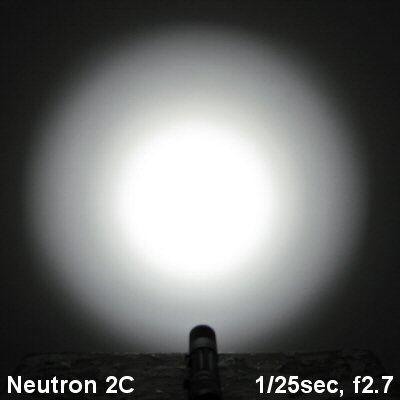
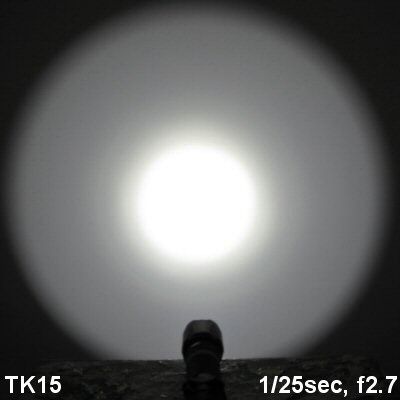
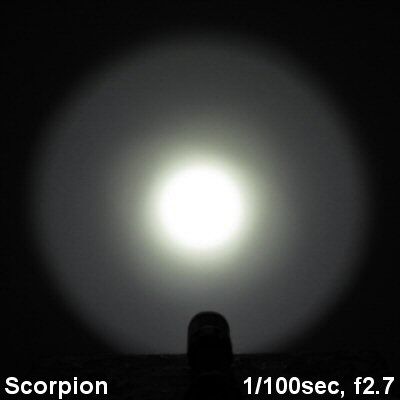
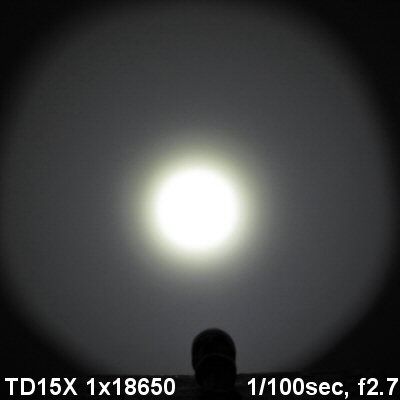
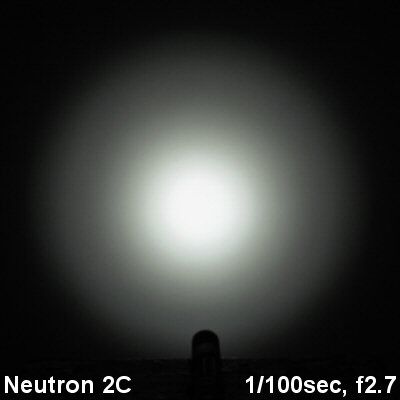
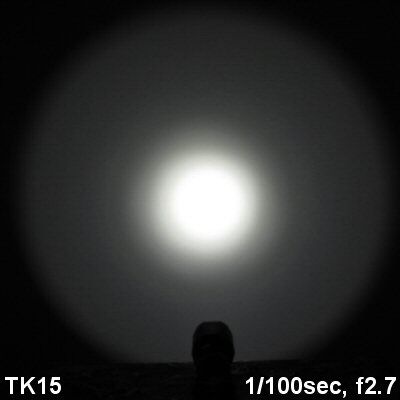
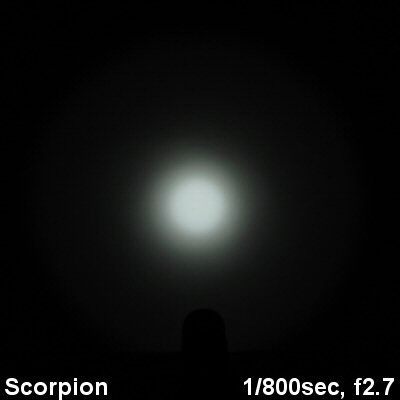
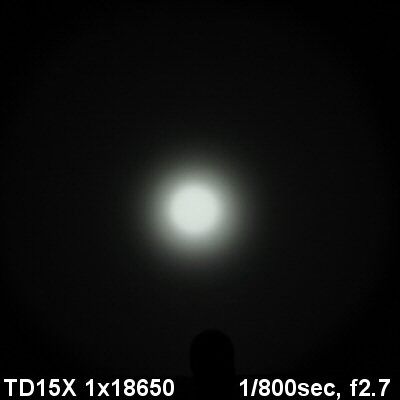
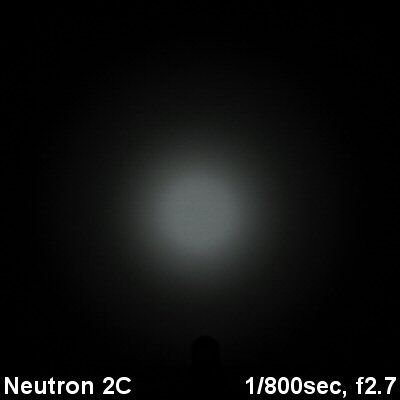
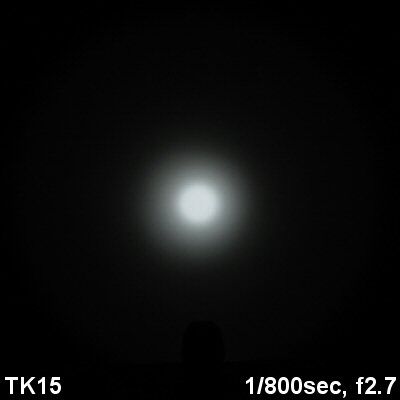
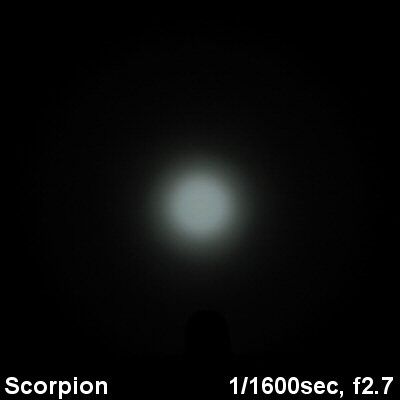
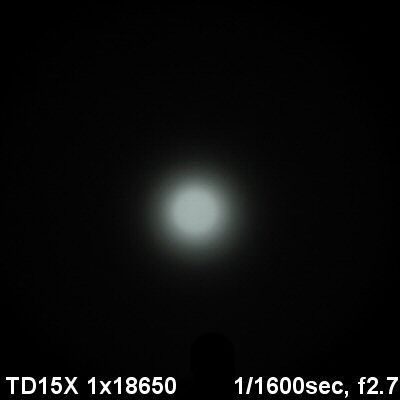
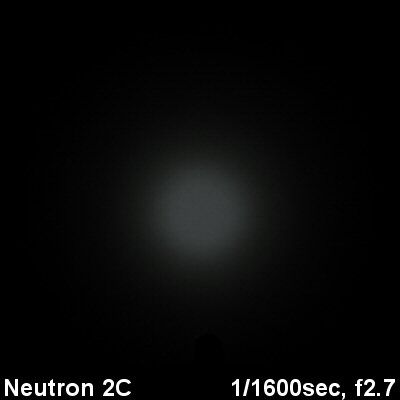
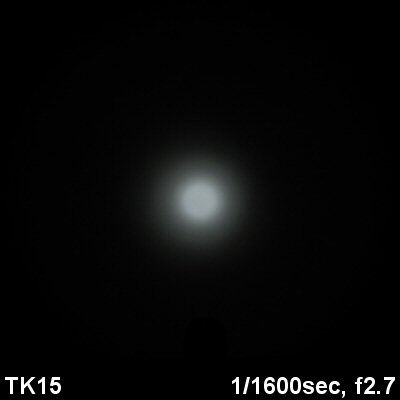
User Interface
My review sample didn't come with a manual, so I am not sure what instructions are typically included. As such, I will describe the UI in some detail.
Tailcap
First off, care has to be taken in how you screw on the tailcap. The raised ridge on the interior assembly must be lined up with the groove on the body tube before screwing it down. To do this, use the plastic control ring to line up the switch internals, and then screw down the tailcap by holding the metal grip ring/knurled area (making sure not to twist the control ring while doing so). In practice, I found the light to be fairly forgiving with this maneuver, as long as you go slowly – but you still need to be careful and pay attention to the resistance feel.
Only when fully assembled will you feel four clear detents on the plastic control ring, for the four output modes of the light (Firefly, Continuously-variable brightness, Momentary max, and Momentary strobe – arranged clockwise, if you are looking at the tailcap button). Before fully locking into the groove, there is no resistance in the control ring.
A quirk to note here – there is a brief max output pre-flash when making initial contact of the tailcap with the battery, and potentially a second pre-flash when fully tightened. According to Thrunite, this pre-flash is integral to how the light functions. With the tailcap fully connected, there is no pre-flash when activating the light in any mode.
Another quirk – when fully-assembled, you can easily turn the plastic control ring beyond the four detents. If you do this, you will feel a slight ridge-bumping feeling under the ring (i.e. like you are forcing it to go somewhere it doesn't want to). Don't worry, this doesn't seem to harm the light – simply reverse your direction, and you will feel the detents immediately again.
Activation
The light is clearly designed to be used in overhand tactical stance (i.e. hand gripping the body of the light with your thumb and index finger on the control ring). To activate the light, first turn the control ring to the mode/detent that you want. Press the plastic switch button to activate in that mode (press and hold for momentary modes, press and release for Firefly or Continuously-variable modes). Note that you should set the ring first, before activating the light. If you turn the control ring while the light is on, nothing will happen until you flash the light off/on again (i.e. it won't change modes while continuously on).
Lock-out
To lock-out the light, the "official" method is to start from the Firefly setting on the control ring, partially depress the switch, and turn the control ring to the left (i.e. counterclockwise). This locks the switch partially depressed, and you lose all the detents on the ring (i.e. just the slight ridge-bumping feeling if you turn it). At this point, the light won't come on or off by the switch until your turn the ring again while holding down the switch (which causes it to release the lock on the switch, which pops back out).
FYI, I found this "lock-out" mode takes a little practice to get the feel right. And you can just as easily get it to "lock-out" the switch while the light is on (i.e. if you press the switch too far while trying to lock it, you will activate Firefly). This is a problem, as you may not notice the low level at first – but you are now slowly draining your battery while locked. :shakehead
Alternatively, a more reliable way to lock-out the light is to simply unscrew the whole tailcap a quarter turn (by the metal grip area). Note you may experience a pre-flash when re-tightening the tailcap. And you should be careful when tightening the tailcap (always by the metal grip area) not to accidentally rotate the plastic control ring (which needs to stay fixed during tailcap assembly)
Continuously-Variable mode
To activate the custom level of the Continuously-variable mode (i.e. 2nd position, clockwise from left), simply press and release the switch (and press-release again to turn off).
To set the output level of this mode, press and hold the switch from Off. The light will ramp up from the current set level to maximum, flash twice, then ramp back down to minimum (flash twice again), and repeat. This cycle continues until you let go of the switch button, at which point the current level is set and memorized until you do another ramp. Note the lowest output level of the ramp is not as low as Firefly (see my Summary table for estimates).
UPDATE April 6, 2011: It seems that the Scorpion deviates from the Gladius on this point. The Gladius ramp can apparently be activated from the On state (the Scorpion can't), and you can reverse the direction of the Gladius ramp by a quick flash off-on (the Scorpion just turns off). Also, there can be a a short re-activation delay on the Scorpion when setting the ramp - if you flash off-on too quickly, the light may not re-illuminate (i.e. need to wait a sec).
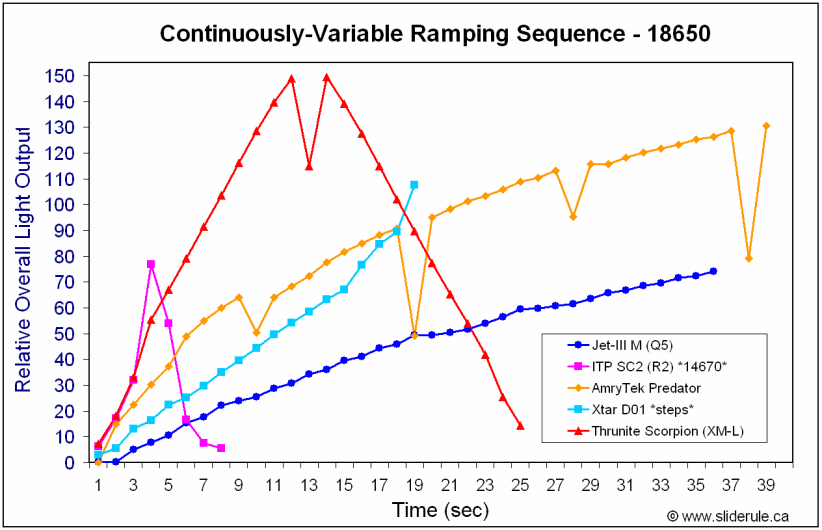
The ramp is fairly quick at around 12 secs min-to-max, and fairly visually-linear, as you can see above.
Momentary modes
Momentary Max output and Strobe are self-explanatory – simply hold the switch down when the control ring is in these positions (3rd an 4th detents, clockwise).
Standby Current
Any light with an electronic control ring must have a standby current. Normally, I just hook up the DMM leads at the tail of the light without the tailcap in place, and take a reading. Here, all I get if I do that is a brief pre-flash and then zero current.
I therefore presume there must be some sort of circuit in the tailcap that needs to be included in the detection path. Measuring with the battery in contact with both the head and tail simultaneously is not something I can easily probe.
So, as a quick and simple test, I left a fully charged battery in the light for a week (after a brief Firefly activation) to see if there was any significant drop in resting voltage. There wasn't – a week later, the cell showed the same resting voltage as a similarly charged matching cell that was left on the shelf the whole time. This suggests to me that the standby current must be low enough that it would take at least months (or more likely years) to significantly drain a battery.
PWM/Strobe
The Scorpion uses a consistent PWM across all levels of the continuously-variable ramp:
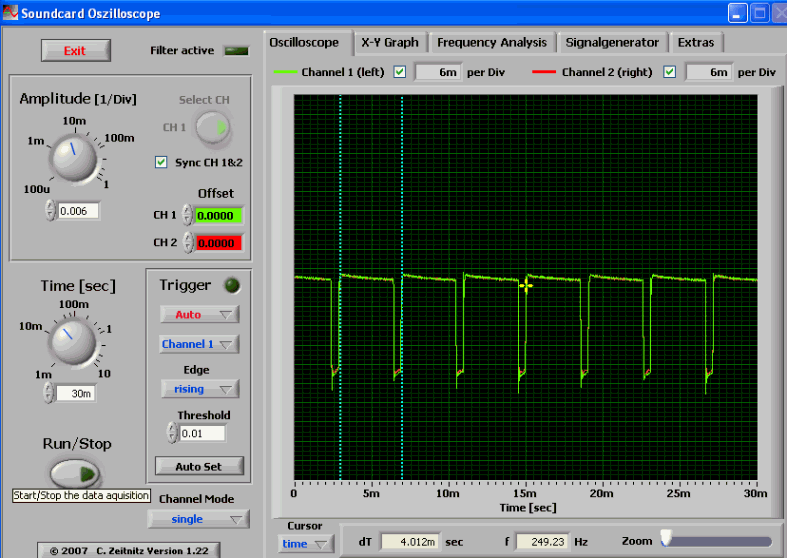
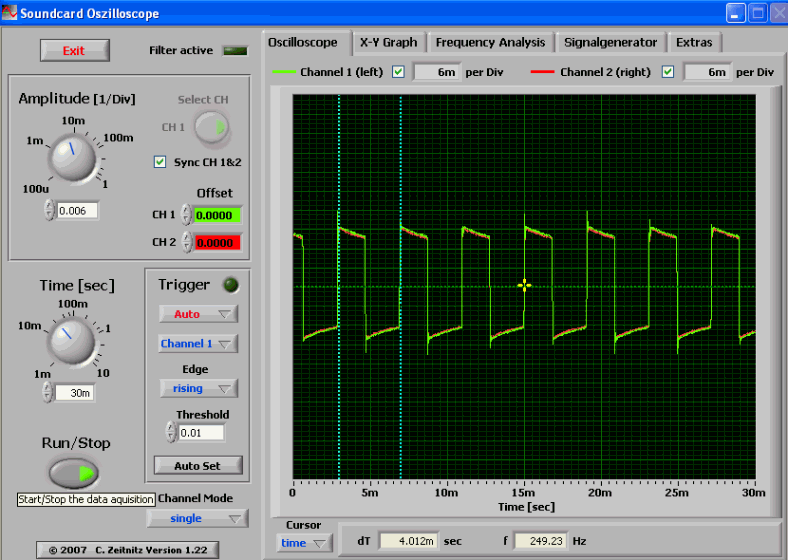
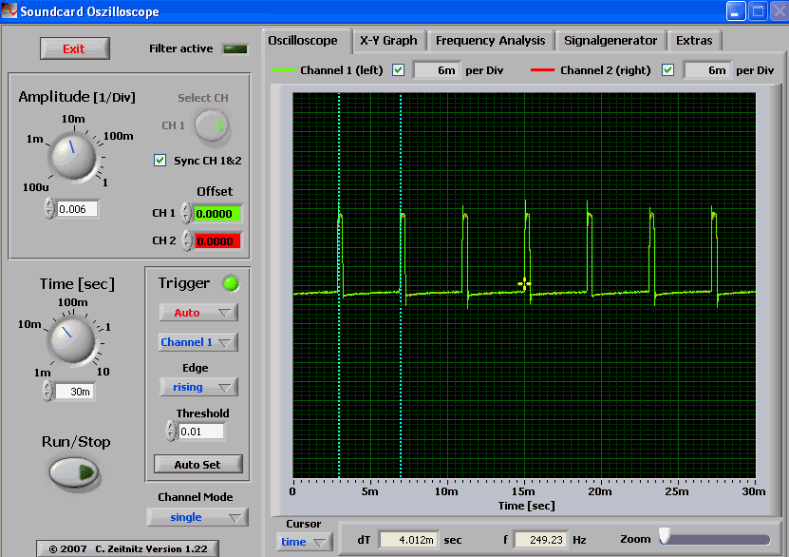
PWM was measured at 250 Hz. This is generally considered to be around the upper limit for visual detection in everyday use (although you can of course detect higher frequencies by shining on a fan or running water). I am personally sensitive to PWM, but I did not find this freq to be noticeable, except as the very lowest output levels.
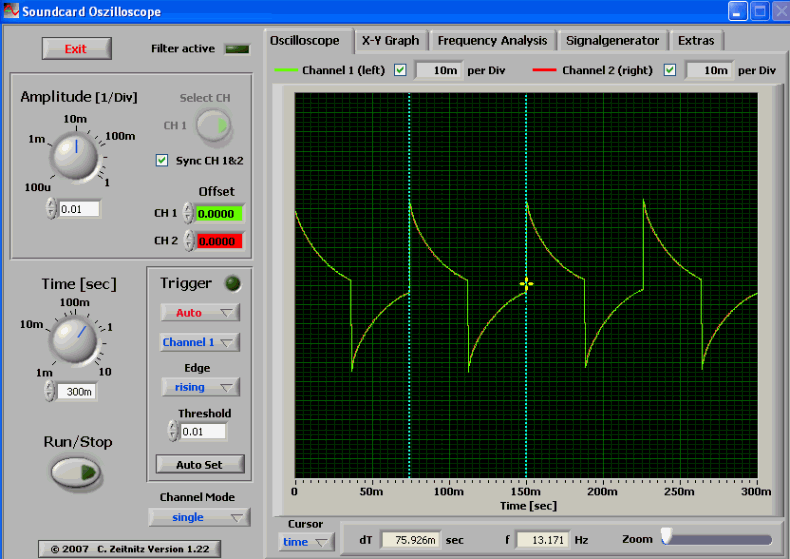
Strobe is 13.1 Hz on my sample, similar to the Neutron series.
Testing Method:
All my output numbers are relative for my home-made light box setup, a la Quickbeam's flashlightreviews.com method. You can directly compare all my relative output values from different reviews - i.e. an output value of "10" in one graph is the same as "10" in another. All runtimes are done under a cooling fan, except for any extended run Lo/Min modes (i.e. >12 hours) which are done without cooling.
I have recently devised a method for converting my lightbox relative output values (ROV) to estimated Lumens. See my How to convert Selfbuilt's Lighbox values to Lumens thread for more info.
Throw/Output Summary Chart:
Effective November 2010, I have revised my summary tables to match with the current ANSI FL-1 standard for flashlight testing. Please see http://www.sliderule.ca/FL1.htm for a description of the terms used in these tables.
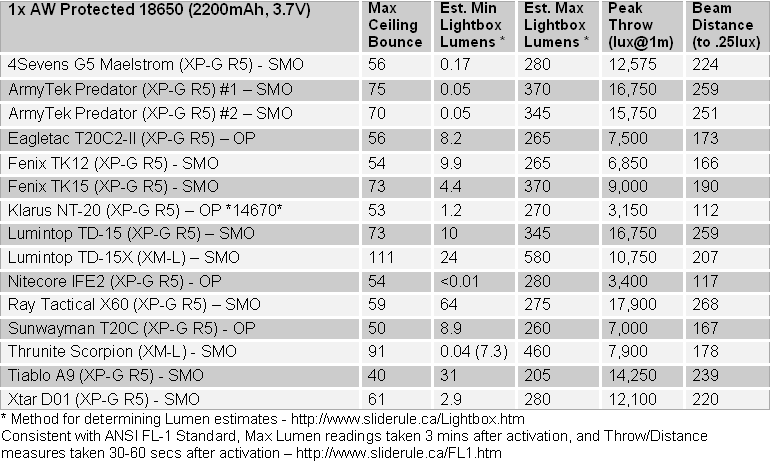
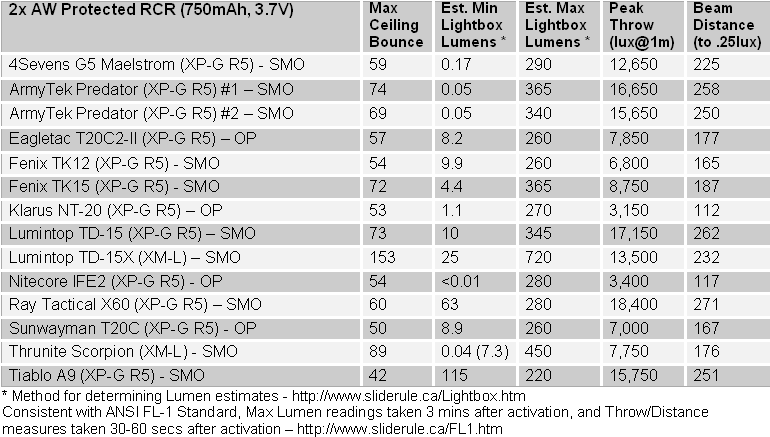
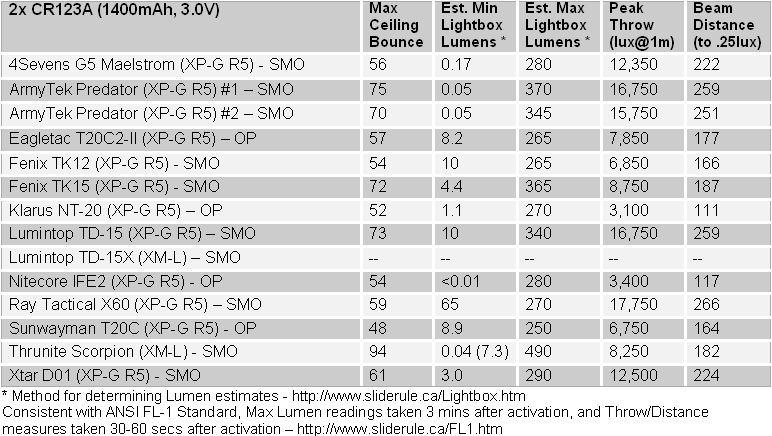
Note that the Min lumen estimate is based on the Firefly mode. The lowest level of the continuously-variable ramp is shown in brackets.
Output/Runtime Comparison:
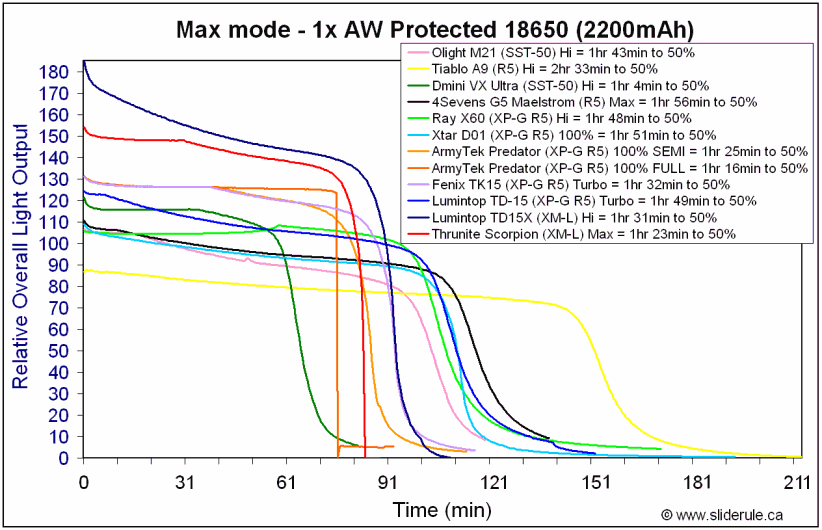
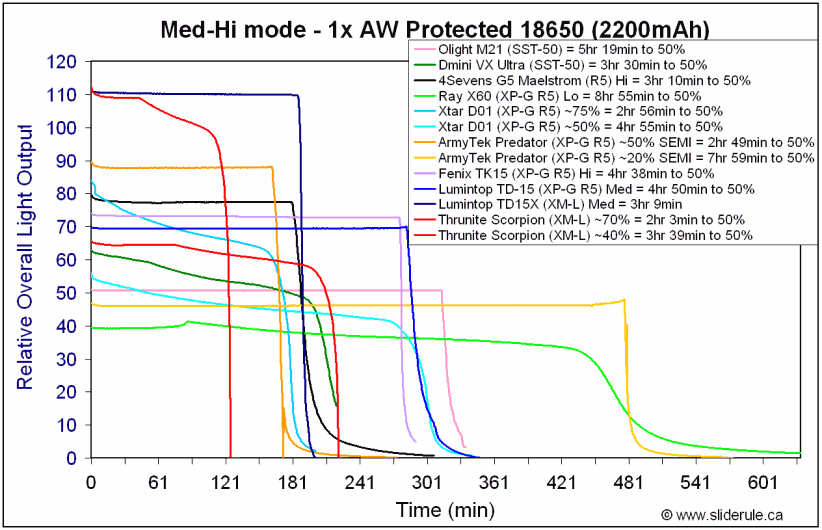
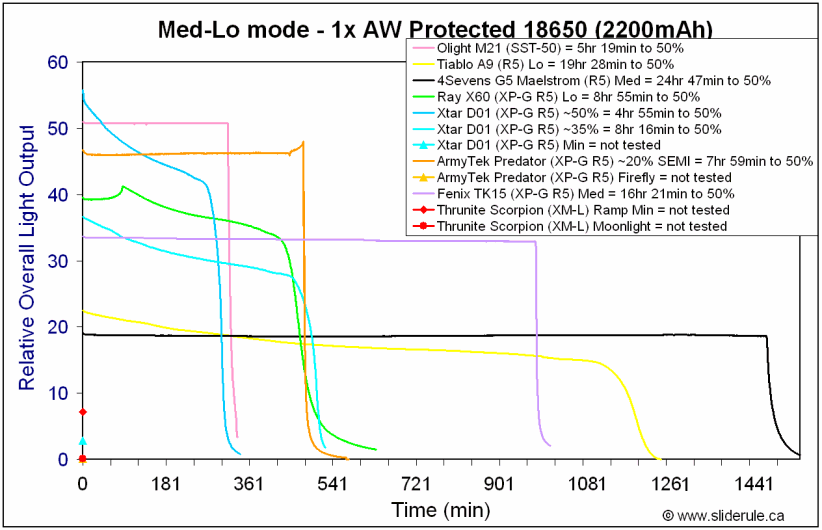
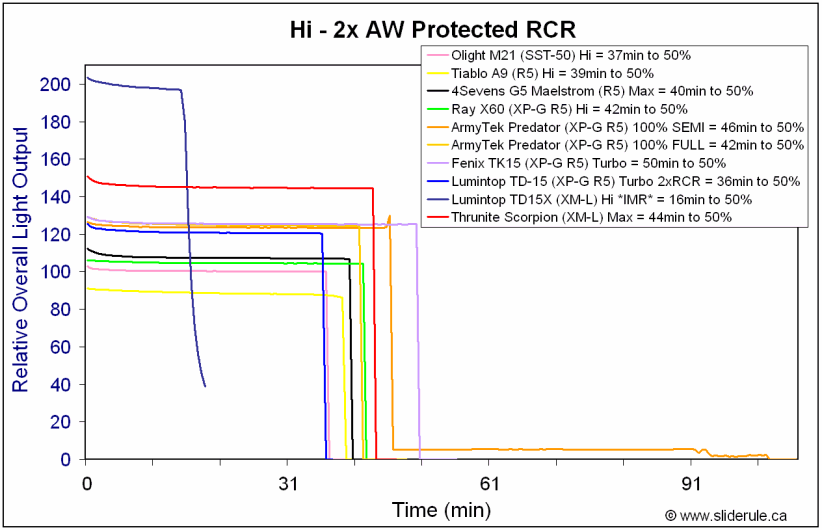
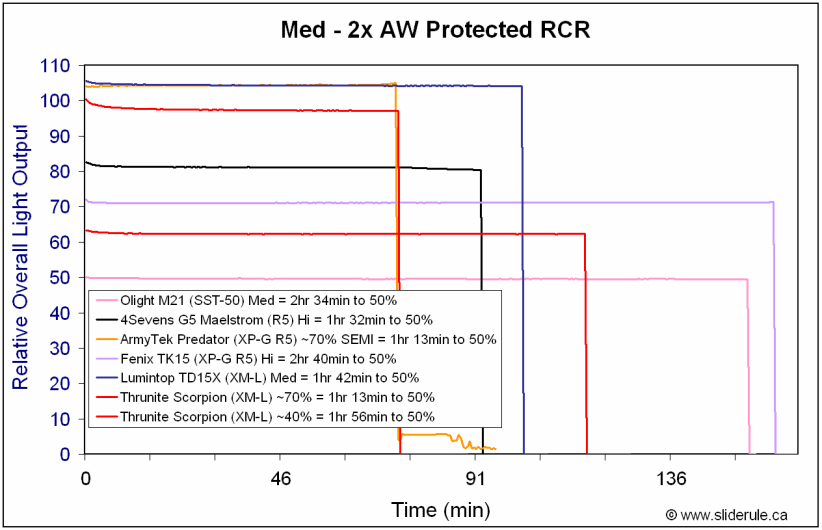
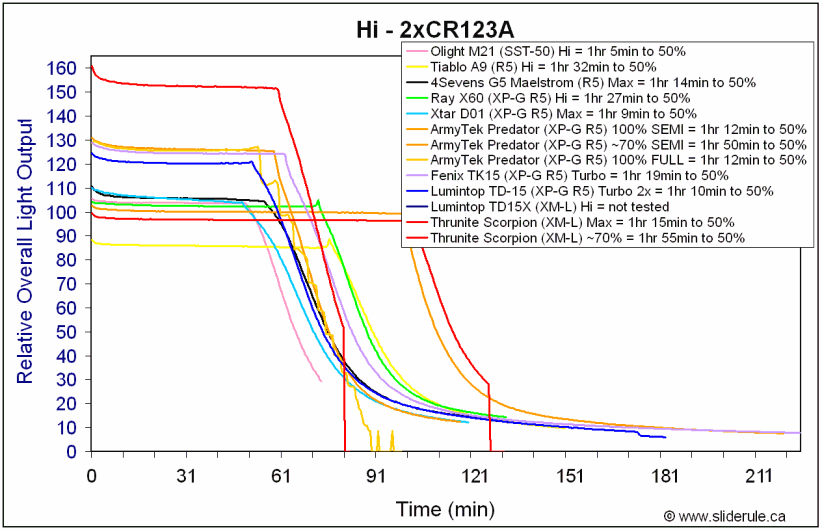
Note the abrupt shut-off as the light nears the end of the run, on all batteries. This is due to the low-voltage cut-off feature of the light (2.9V). You will get a series of flashes warning you the light is about to shut-off, right before this occurs.
Potential Issues
The tailcap control ring has a unique feel and somewhat complicated action until you get used to it (see my detailed discussion of the user interface earlier in this review). Once you get the hang of it, you should be able to reliably get it to do what you want.
The tailcap switch cover and control ring are made of some sort of polymer (i.e. plastic). However, Thrunite assures me that they are extremely durable and can easily survive heavy usage and abuse. I have not experienced any problems in my testing (and I gather the Night Ops Gladius uses something similar).
There is a high output pre-flash when making initial contact of the battery with the tailcap, and potentially a second one when fully tightened. This pre-flash is apparently integral to how the light functions. With the tailcap fully connected, there is no pre-flash when activating the light in any mode.
The light uses visible PWM on its continuously-variable output mode, and the frequency is at the high-end of the typical visual detection range (250 Hz). This is not likely to be distracting in everyday use, although it is potentially noticeable (especially at the lower outputs) for those who are very sensitive to it.
Although the Scorpion has springs at both ends of the battery tube, a number of my newer high capacity flat-top 18650 cells wouldn't work. The issue seems to be tightening the tailcap all the way to insure contact – I found this difficult with some of the longer cells (i.e. too much resistance with the springs?).
Output/runtime efficiency seems low for a XM-L based light, at all outputs below Max. Efficiency seems closer to an XP-G R5-based light at most output levels.
Clip is removable, but not reversible.
The Scorpion deviates from the Gladius on setting the Continuously-variable ramp. The Scorpion can only be set from Off, while the Gladius ramp can apparently be activated from On. Also, you can reverse the direction of the Gladius ramp by a quick flash off-on (the Scorpion just turns off). Also, there can be a a short re-activation delay on the Scorpion when setting the ramp - if you flash off-on too quickly, the light may not re-illuminate (i.e. need to wait a sec).
Preliminary Observations
As with any distinctive design, there is always a lot to discuss. :sweat: I don't want to repeat myself here, so I suggest you scroll back up to the User Interface and Potential Issues sections for greater discussion of the control ring and features of this light. But just to be clear – the Scorpion control ring is not as complex as the above discussion may make it sound. I have spent a lot time describing it simply because it is distinctive, and therefore likely different from what you may have experienced before. But it is not actually novel – it looks and performs very similar to the Night Ops Gladius, with an extra mode (Firefly). That said, the Scorpion does have a few functional quirks that the Gladius lacks (e.g. activation delay on ramp, having to wait for it to finish before reversing, etc.).
Like the Gladius, this design is clearly made to accommodate "tactical" uses. I can't speak to that point, so I will let others with more experience comment. I can see the relative advantage of not having to switch your hand grip after activation (i.e. all modes can be easily cycled one-handed in over-hand tactical grip on the Scorpion). This is actually a nice feature that you don't get with the dual control structure of traditional head control rings and tailcap clickies. :thumbsup:
That being said, I do find it a bit peculiar that you need to flash the switch off/on to change modes (i.e. when on, turning the control ring does nothing until you flash). I suspect this has to do with how control ring actually works, but it is a little odd. :shrug: And of course, this also means you get to set the output mode you want before turning on the light - a key point for "tactical" use.
Build-wise, I like the substantial feel of the light. Once you understand how the control ring functions, you should find it fairly easy to activate the mode you want. Of course, build design is matter of relative preference - if you don't like the rather rakish look, there's always the slim-lined Neutron series to consider.
Performance is reasonable on the Max setting (i.e. a good amount of light, for a reasonable amount of time). While the light may not be driven quite as high as some other XM-L lights, it is still brighter than any XP-G light. However, at the lower outputs (accessed through the Continuously-variable mode), efficiency seems to drop to around that of a typical XP-G R5 level (or lower). I noticed something similar in my review of the Thrunite Neutron 2A. :thinking:
Beam pattern is pretty good for a XM-L equipped light. No, it is not a thrower, but it seems reasonably well balanced between spot and spill. An OP reflector may help to smooth the beam a little further, but the SMO was fine in my testing.
At the end of the day, I think the decision to get this light hinges on the interface and control mechanism. If you are a fan of the Night Ops Gladius, you will like the much higher output here (plus Firefly mode). The interface is similar, but with a few more quirks on the Scorpion. Still, it seems to be a sturdy tactical light.
UPDATE JUNE 8, 2011: Thrunite has revised the Scorpion with a new version that address all the issues identified in this review (along with greatly increased max output, efficiency, and throw). Check my new Scorpion V2 review for the currently shipping version.
----
Scorpion provided by Thrunite for review.
UPDATE JUNE 8, 2011: Thrunite has revised the Scorpion with a new version that address all the issues identified in this review (along with greatly increased max output, efficiency, and throw). Check my new Scorpion V2 review for the currently shipping version.

The Scorpion is a new XM-L based light from Thrunite, with an interesting tailcap control interface. Let's see how it performs …
Specifications:
- Cree XM-L (T6) LED
- Uses 2 x 3V CR123A batteries (Lithium) or one 18650 rechargeable battery (Li-ion)
- Dimensions: 164mm (Length) x 25mm (Diameter) x 35mm (Head), Weight: 5.4oz weight (without batteries)
- Digitally regulated output - maintains constant brightness(1.5A)
- Reverse polarity protection, to protect from improper battery installation
- Battery low voltage warning system: when battery voltage drops to 2.9v., output will drop to a very low level, and shut off at 2.7v
- Made of durable aircraft-grade aluminum
- Premium Type III hard-anodized anti-abrasive finish
- Toughened ultra-clear glass lens with anti-reflective coating
- Removable clip
- Removable crenellated SS bezel
- Smooth reflector (30mm diameter; 24mm depth) maintains very good throw.
- The Scorpion features a unique five stage UI with a twist ring on the tail cap. The ring rotates from left to right for the following modes: Lock out, Firefly, Infinite brightness, momentary, and momentary strobe.
- Typical Output and Runtimes:
- Firefly mode: 0.1 lumens, 9 days
- Infinite brightness: variable depending on setting and battery capacity. On high, approx.1hour
- Max: 460ANSI lumens, 1 hour (2xCR123A)
- Strobe (10hz, 460 lumens): 2hours
- Estimated MSRP ~$120


Packaging is similar to the Catapult line of lights (i.e. simple cardboard case with cut-out foam). Iinside you will find the light, wrist lanyard, and spare o-rings. There was no manual or warranty card on my sample, but those are usually standard with Thrunite.


From left to right: Surefire CR123A, Redilast 18650, Thrunite Scorpion, 4Sevens Maelstrom G5, Armytek Predator, Lumintop TD-15, Sunwayman T20C, NiteCore IFE2.
Scorpion: Weight: 167.5g (no batteries), Length: 168mm, Width: 35.1 (bezel), 37.0mm (tailcap grip ring)
TD-15X: Weight 150.3g (no batteries), Length 147.3mm, Width: 37.8mm (bezel)
The Scorpion is a bit beefier that other lights in this class, with apparently heavier heatsinking in the head (noticeable head weight difference compared to other lights). Length is also a little longer than typical, due to the control ring in the tailcap.


The most distinctive part of this light is the tailcap, so let me get the other items out of the way first.
The head is a bit heftier than most lights, and seems to have excellent heatsinking. Since the tailcap is also beefier than normal, this tends to balance out the weight reasonably well. Overall, the light feels quite solid and durable – as you would expect from Thrunite.
Clip is removable, with a knurled ring cover to hide the attachment point. Note the clip is not reversible, however.
Black anodizing (type III = HA) is in matte finish, similar to the Neutron series. Lettering (which is minimal) is bright and clear. Knurling is reasonably aggressive (similar to the Neutron series), and there is a generous amount of it over the light and tailcap. Grip is good, especially with the removable clip and built-in tailcap aluminum grip ring.
Square-cut screw threads are anodized for tailcap lock-out.
There is a spring on the positive contact plate in the head, insuring contact for flat-top cells. Be advised however that I had trouble getting most of my high-capacity 18650 cells to work in the light. I suspect the problem was the resistance of the two battery springs making it hard to screw the tailcap all the way down (i.e. to get past the anodized lock-out).
Light cannot tailstand.
So, what about that tailcap?


First off, doesn't it look familiar? Although I don't own one, it appears to be remarkably similar to the Night-Ops Gladius. Not surprisingly, the interface is also nearly identical to that of the Gladius, except for the addition of the extra Firefy mode on the Scorpion.
The tailcap exterior is composed of two distinct regions – a metal base (the grip ring and knurled region) and a polymer (i.e. plastic) control ring and switch. The control ring is directly connected to the substantial spring assembly unit inside the head, and the whole area spins freely when the tailcap is not attached. Aside from aesthetic touches - like the "TN" logo stamped on the button, and the shape of the grip ring and knurling - this tailcap is a dead ringer for the Gladius.


On the interior of the switch, you will see there is a small ridge, or raised area of the switch base (arrow in the top pick). This corresponds to the grove clearly visible on the inside of the body tube (arrow in the bottom pic). Again, this is identical to the Gladius – that raised area on the switch locks into this groove during assembly.
 It is very important you carefully line up the groove area with the tailcap ridge (by turning the plastic control ring) before tightening the switch assembly (by screwing the tailcap by the metal grip area). Although it was fairly forgiving in my testing, you don't ever want to force the tailcap when screwing on - you may damage the switch if overly careless. Once in the groove, the control ring now moves between 4 clear detents that set the output modes of the light.
It is very important you carefully line up the groove area with the tailcap ridge (by turning the plastic control ring) before tightening the switch assembly (by screwing the tailcap by the metal grip area). Although it was fairly forgiving in my testing, you don't ever want to force the tailcap when screwing on - you may damage the switch if overly careless. Once in the groove, the control ring now moves between 4 clear detents that set the output modes of the light.For more on how the control ring works, please see my User Interface discussion below.


The Scorpion has a fairly deep and smooth reflector, with a well-centered XM-L emitter on my sample. I would expect reasonably good throw with this reflector, but not as great as larger "thrower" lights.
Which brings me to the white-wall beamshots.
















User Interface
My review sample didn't come with a manual, so I am not sure what instructions are typically included. As such, I will describe the UI in some detail.
Tailcap
First off, care has to be taken in how you screw on the tailcap. The raised ridge on the interior assembly must be lined up with the groove on the body tube before screwing it down. To do this, use the plastic control ring to line up the switch internals, and then screw down the tailcap by holding the metal grip ring/knurled area (making sure not to twist the control ring while doing so). In practice, I found the light to be fairly forgiving with this maneuver, as long as you go slowly – but you still need to be careful and pay attention to the resistance feel.
Only when fully assembled will you feel four clear detents on the plastic control ring, for the four output modes of the light (Firefly, Continuously-variable brightness, Momentary max, and Momentary strobe – arranged clockwise, if you are looking at the tailcap button). Before fully locking into the groove, there is no resistance in the control ring.
A quirk to note here – there is a brief max output pre-flash when making initial contact of the tailcap with the battery, and potentially a second pre-flash when fully tightened. According to Thrunite, this pre-flash is integral to how the light functions. With the tailcap fully connected, there is no pre-flash when activating the light in any mode.
Another quirk – when fully-assembled, you can easily turn the plastic control ring beyond the four detents. If you do this, you will feel a slight ridge-bumping feeling under the ring (i.e. like you are forcing it to go somewhere it doesn't want to). Don't worry, this doesn't seem to harm the light – simply reverse your direction, and you will feel the detents immediately again.
Activation
The light is clearly designed to be used in overhand tactical stance (i.e. hand gripping the body of the light with your thumb and index finger on the control ring). To activate the light, first turn the control ring to the mode/detent that you want. Press the plastic switch button to activate in that mode (press and hold for momentary modes, press and release for Firefly or Continuously-variable modes). Note that you should set the ring first, before activating the light. If you turn the control ring while the light is on, nothing will happen until you flash the light off/on again (i.e. it won't change modes while continuously on).
Lock-out
To lock-out the light, the "official" method is to start from the Firefly setting on the control ring, partially depress the switch, and turn the control ring to the left (i.e. counterclockwise). This locks the switch partially depressed, and you lose all the detents on the ring (i.e. just the slight ridge-bumping feeling if you turn it). At this point, the light won't come on or off by the switch until your turn the ring again while holding down the switch (which causes it to release the lock on the switch, which pops back out).
FYI, I found this "lock-out" mode takes a little practice to get the feel right. And you can just as easily get it to "lock-out" the switch while the light is on (i.e. if you press the switch too far while trying to lock it, you will activate Firefly). This is a problem, as you may not notice the low level at first – but you are now slowly draining your battery while locked. :shakehead
Alternatively, a more reliable way to lock-out the light is to simply unscrew the whole tailcap a quarter turn (by the metal grip area). Note you may experience a pre-flash when re-tightening the tailcap. And you should be careful when tightening the tailcap (always by the metal grip area) not to accidentally rotate the plastic control ring (which needs to stay fixed during tailcap assembly)
Continuously-Variable mode
To activate the custom level of the Continuously-variable mode (i.e. 2nd position, clockwise from left), simply press and release the switch (and press-release again to turn off).
To set the output level of this mode, press and hold the switch from Off. The light will ramp up from the current set level to maximum, flash twice, then ramp back down to minimum (flash twice again), and repeat. This cycle continues until you let go of the switch button, at which point the current level is set and memorized until you do another ramp. Note the lowest output level of the ramp is not as low as Firefly (see my Summary table for estimates).
UPDATE April 6, 2011: It seems that the Scorpion deviates from the Gladius on this point. The Gladius ramp can apparently be activated from the On state (the Scorpion can't), and you can reverse the direction of the Gladius ramp by a quick flash off-on (the Scorpion just turns off). Also, there can be a a short re-activation delay on the Scorpion when setting the ramp - if you flash off-on too quickly, the light may not re-illuminate (i.e. need to wait a sec).

The ramp is fairly quick at around 12 secs min-to-max, and fairly visually-linear, as you can see above.
Momentary modes
Momentary Max output and Strobe are self-explanatory – simply hold the switch down when the control ring is in these positions (3rd an 4th detents, clockwise).
Standby Current
Any light with an electronic control ring must have a standby current. Normally, I just hook up the DMM leads at the tail of the light without the tailcap in place, and take a reading. Here, all I get if I do that is a brief pre-flash and then zero current.
I therefore presume there must be some sort of circuit in the tailcap that needs to be included in the detection path. Measuring with the battery in contact with both the head and tail simultaneously is not something I can easily probe.
So, as a quick and simple test, I left a fully charged battery in the light for a week (after a brief Firefly activation) to see if there was any significant drop in resting voltage. There wasn't – a week later, the cell showed the same resting voltage as a similarly charged matching cell that was left on the shelf the whole time. This suggests to me that the standby current must be low enough that it would take at least months (or more likely years) to significantly drain a battery.
PWM/Strobe
The Scorpion uses a consistent PWM across all levels of the continuously-variable ramp:



PWM was measured at 250 Hz. This is generally considered to be around the upper limit for visual detection in everyday use (although you can of course detect higher frequencies by shining on a fan or running water). I am personally sensitive to PWM, but I did not find this freq to be noticeable, except as the very lowest output levels.

Strobe is 13.1 Hz on my sample, similar to the Neutron series.
Testing Method:
All my output numbers are relative for my home-made light box setup, a la Quickbeam's flashlightreviews.com method. You can directly compare all my relative output values from different reviews - i.e. an output value of "10" in one graph is the same as "10" in another. All runtimes are done under a cooling fan, except for any extended run Lo/Min modes (i.e. >12 hours) which are done without cooling.
I have recently devised a method for converting my lightbox relative output values (ROV) to estimated Lumens. See my How to convert Selfbuilt's Lighbox values to Lumens thread for more info.
Throw/Output Summary Chart:
Effective November 2010, I have revised my summary tables to match with the current ANSI FL-1 standard for flashlight testing. Please see http://www.sliderule.ca/FL1.htm for a description of the terms used in these tables.



Note that the Min lumen estimate is based on the Firefly mode. The lowest level of the continuously-variable ramp is shown in brackets.
Output/Runtime Comparison:






Note the abrupt shut-off as the light nears the end of the run, on all batteries. This is due to the low-voltage cut-off feature of the light (2.9V). You will get a series of flashes warning you the light is about to shut-off, right before this occurs.
Potential Issues
The tailcap control ring has a unique feel and somewhat complicated action until you get used to it (see my detailed discussion of the user interface earlier in this review). Once you get the hang of it, you should be able to reliably get it to do what you want.
The tailcap switch cover and control ring are made of some sort of polymer (i.e. plastic). However, Thrunite assures me that they are extremely durable and can easily survive heavy usage and abuse. I have not experienced any problems in my testing (and I gather the Night Ops Gladius uses something similar).
There is a high output pre-flash when making initial contact of the battery with the tailcap, and potentially a second one when fully tightened. This pre-flash is apparently integral to how the light functions. With the tailcap fully connected, there is no pre-flash when activating the light in any mode.
The light uses visible PWM on its continuously-variable output mode, and the frequency is at the high-end of the typical visual detection range (250 Hz). This is not likely to be distracting in everyday use, although it is potentially noticeable (especially at the lower outputs) for those who are very sensitive to it.
Although the Scorpion has springs at both ends of the battery tube, a number of my newer high capacity flat-top 18650 cells wouldn't work. The issue seems to be tightening the tailcap all the way to insure contact – I found this difficult with some of the longer cells (i.e. too much resistance with the springs?).
Output/runtime efficiency seems low for a XM-L based light, at all outputs below Max. Efficiency seems closer to an XP-G R5-based light at most output levels.
Clip is removable, but not reversible.
The Scorpion deviates from the Gladius on setting the Continuously-variable ramp. The Scorpion can only be set from Off, while the Gladius ramp can apparently be activated from On. Also, you can reverse the direction of the Gladius ramp by a quick flash off-on (the Scorpion just turns off). Also, there can be a a short re-activation delay on the Scorpion when setting the ramp - if you flash off-on too quickly, the light may not re-illuminate (i.e. need to wait a sec).
Preliminary Observations
As with any distinctive design, there is always a lot to discuss. :sweat: I don't want to repeat myself here, so I suggest you scroll back up to the User Interface and Potential Issues sections for greater discussion of the control ring and features of this light. But just to be clear – the Scorpion control ring is not as complex as the above discussion may make it sound. I have spent a lot time describing it simply because it is distinctive, and therefore likely different from what you may have experienced before. But it is not actually novel – it looks and performs very similar to the Night Ops Gladius, with an extra mode (Firefly). That said, the Scorpion does have a few functional quirks that the Gladius lacks (e.g. activation delay on ramp, having to wait for it to finish before reversing, etc.).
Like the Gladius, this design is clearly made to accommodate "tactical" uses. I can't speak to that point, so I will let others with more experience comment. I can see the relative advantage of not having to switch your hand grip after activation (i.e. all modes can be easily cycled one-handed in over-hand tactical grip on the Scorpion). This is actually a nice feature that you don't get with the dual control structure of traditional head control rings and tailcap clickies. :thumbsup:
That being said, I do find it a bit peculiar that you need to flash the switch off/on to change modes (i.e. when on, turning the control ring does nothing until you flash). I suspect this has to do with how control ring actually works, but it is a little odd. :shrug: And of course, this also means you get to set the output mode you want before turning on the light - a key point for "tactical" use.
Build-wise, I like the substantial feel of the light. Once you understand how the control ring functions, you should find it fairly easy to activate the mode you want. Of course, build design is matter of relative preference - if you don't like the rather rakish look, there's always the slim-lined Neutron series to consider.
Performance is reasonable on the Max setting (i.e. a good amount of light, for a reasonable amount of time). While the light may not be driven quite as high as some other XM-L lights, it is still brighter than any XP-G light. However, at the lower outputs (accessed through the Continuously-variable mode), efficiency seems to drop to around that of a typical XP-G R5 level (or lower). I noticed something similar in my review of the Thrunite Neutron 2A. :thinking:
Beam pattern is pretty good for a XM-L equipped light. No, it is not a thrower, but it seems reasonably well balanced between spot and spill. An OP reflector may help to smooth the beam a little further, but the SMO was fine in my testing.
At the end of the day, I think the decision to get this light hinges on the interface and control mechanism. If you are a fan of the Night Ops Gladius, you will like the much higher output here (plus Firefly mode). The interface is similar, but with a few more quirks on the Scorpion. Still, it seems to be a sturdy tactical light.
UPDATE JUNE 8, 2011: Thrunite has revised the Scorpion with a new version that address all the issues identified in this review (along with greatly increased max output, efficiency, and throw). Check my new Scorpion V2 review for the currently shipping version.
----
Scorpion provided by Thrunite for review.
Last edited:


